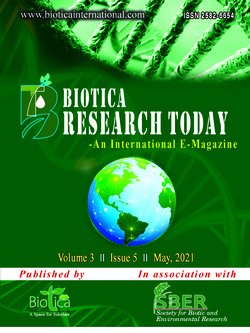
A Multi-Trait Mechanisms of PGPR in Plant Disease Management
Murali Sankar, P.*
Dept. of Plant Pathology, SRSIAT, Vedasandur, Dindigul, Tamil Nadu (624 710), India
Shreedevasena, S.
Dept. of Plant Pathology, UAS, GKVK, Bangalore, Karnataka (560 065), India
Kaviyarathinam, T.
Dept. of Plant Pathology, SRSIAT, Vedasandur, Dindigul, Tamil Nadu (624 710), India
Syamala, M.
Dept. of Plant Pathology, TIAC, Raadhapuram, Tamil Nadu (627 111), India
DOI: NIL
Keywords: Biocontrol, DAPG, PGPR, Siderophore
Abstract
In today, science has developed in all the sectors around global wide, but the starvation, nutrient deficiencies, new emerging diseases and mortality were increased due to population growth rate, land degradation, soil nutrient loss and insufficient level of food sources and highest demand. Under these situations, global level scientific visions and approaches were highly focused on the usage of microorganisms in the agriculture and related sectors as a green way or “organic agriculture”. This approach was applied in the strategies such as biocontrol, biofertilizers and biopesticides (PGPR and fungi). These microorganisms were used on the basis of biological and metabolic pathways. Using beneficial microbes (PGPR) is a tremendous nature oriented because it needs highly knowledgeable about microorganisms. When we assumed it, all living organisms and nature become the safest one achieved with harmless-green way of food security on the earth.
Downloads
not found
Reference
Reis, V.M., Bruno, J.R.A., Hartmann, A., James, E.K., Zilli, J.E., 2020. Beneficial microorganisms in agriculture: the future of plant growth-promoting rhizobacteria. Plant Soil 45, 1-3.
El-sayed, S.A., Algarni, A.A., Shaban, K.A.H., 2020. Effect of NPK nano-fertilizers and compost on soil fertility and root rot severity of soybean plants caused by Rhizoctonia solani. Plant Pathol. J 19(2), 140-150.
Maharajan, T., Ceasar, S.A., Ajeesh Krishna, T.P., Ramakrishnan, M., Duraipandiyan, V. Naif Abdulla, A.D., 2018. Utilization of molecular markers for improving the P efficiency in crop plants. Plant Breed 137, 10-26.
